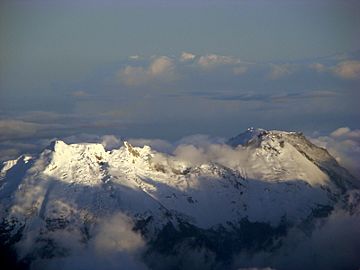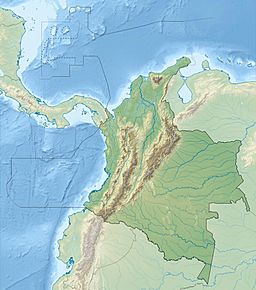Nevado del Huila facts for kids
Quick facts for kids Nevado del Huila |
|
|---|---|

Nevado del Huila in December 2008
|
|
| Highest point | |
| Elevation | 5,364 m (17,598 ft) |
| Prominence | 2,650 m (8,690 ft) |
| Listing | Ultra |
| Geography | |
| Location | Cauca, Huila & Tolima |
| Parent range | Central Ranges Andes |
| Geology | |
| Mountain type | Andesitic stratovolcano |
| Volcanic arc/belt | North Volcanic Zone Andean Volcanic Belt |
| Last eruption | 2008 to 2012 |
Nevado del Huila is the highest volcano in Colombia, a country in South America. It stands tall at 5,364 meters (about 17,600 feet) above sea level. This giant volcano is located where three different areas, called departments, meet: Huila, Tolima, and Cauca. You can even see it from the city of Cali on a clear day! It's a type of volcano called a stratovolcano, which means it's shaped like a cone and built up by many layers of hardened lava and ash.
The volcano was quiet for over 500 years, which means it was "dormant." But then, it started showing signs of waking up in 2007 and 2008. Starting in February 2007, there were more than 7,000 small earthquakes inside the volcano. This led to a high alert for the nearby departments. The volcano erupted a few times in 2007 and 2008. People living near the volcano, especially in small villages like Páez, remember past eruptions. They know how important it is to be ready for a volcano to erupt.
Contents
Major Eruptions
The 2007 Eruption
On April 18, 2007, Nevado del Huila erupted twice. These eruptions caused large amounts of snow and ice to melt quickly, creating avalanches that flowed into the Paez River. This made the water levels rise in the Magdalena River as well. More than 4,000 people living nearby were moved to safety, and thankfully, no one was hurt.
Activity and Eruptions in 2008
Nevado del Huila became active again in March 2008. After many small earthquakes inside the volcano, Colombian officials declared a "yellow alert" on March 18. This means there was a chance of an eruption. The alert level was then raised to "orange" on March 29, meaning an eruption was likely within two weeks. Hundreds of people were moved away from the area to keep them safe.
November 2008 Eruption
On April 14, 2008, at 11:08 PM, the volcano erupted, sending ash into the sky. The government immediately issued a "red alert," which is the highest warning level. Between 13,000 and 15,000 people living near the mountain were asked to leave their homes. After the activity calmed down, the red alert was lowered back to orange on April 16.
Later that year, on November 20, 2008, the volcano erupted again. This happened at 2:45 AM GMT (which was 9:45 PM local time on November 20). Colombian officials quickly started a large-scale evacuation. Some people in the towns were hesitant to leave their homes.
The eruption caused a massive avalanche of earth and rocks. This avalanche damaged homes, bridges, and farm crops. Three small towns along the Páez River—Paicol, La Plata, and Belalcázar—were affected. Sadly, this eruption caused some deaths, and emergency services found it hard to reach many remote areas. About 12,000 people living nearby were moved to safety.
Thanks to a special national system that helps prevent disasters, many lives were saved. This system had placed instruments on the volcano to watch it closely. It also trained local people in high-risk areas and set up alarms in nearby towns. Colombia's President Álvaro Uribe ordered the Air Force of Colombia to create an "air bridge." This meant using planes to deliver supplies to towns along the Páez River that were cut off by the eruption.
See also
 In Spanish: Nevado del Huila para niños
In Spanish: Nevado del Huila para niños
- List of volcanoes in Colombia
- List of volcanoes by elevation


